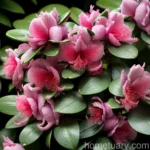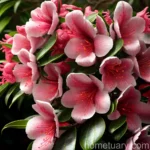Understanding the Evergreen Azalea (Rhododendron ‘Hino-crimson’)
What is an Azalea Plant?
The evergreen azalea, scientifically known as Rhododendron ‘Hino-crimson’, belongs to the genus Rhododendron and is part of the Ericaceae family. Azaleas are popular as flowering shrubs and are prized for their vibrant, showy blooms that adorn gardens and landscapes.
Key Takeaways – Evergreen Azalea (Rhododendron ‘Hino-crimson’)
Before diving into the specifics of the evergreen azalea, let’s take a look at a summary of the key takeaways of this beautiful plant:
- Azalea Plant:
- Belongs to the Rhododendron family
- Notable for its vibrant and showy blooms
-
Commonly known as “evergreen azalea” or “Rhododendron ‘Hino-crimson'”
-
Culture:
- Requires acidic soil
- Benefits from regular pruning
-
Well-suited for container gardening
-
Uses:
- Popular in landscaping and gardens
- Suitable for creating colorful borders
-
Adds visual appeal to shaded areas
-
Water:
- Requires regular watering
-
Avoids waterlogging
-
Sunlight:
- Flourishes in partial shade
-
Thrives in dappled sunlight
-
Fertilizer:
- Benefits from acidic fertilizer
-
Fertilize before the blooming season
-
Soil:
- Flourishes in well-draining, acidic soil
-
Requires organic matter for healthy growth
-
Pruning:
- Regular pruning for shape and size control
-
Removes dead and diseased branches
-
Propagation:
- Possible through softwood cuttings
-
Air layering is another propagation method
-
Container Popularity:
- Ideal for container gardening
-
Suitable for patio or balcony spaces
-
Common Diseases:
- Susceptible to leaf spots and petal blight
-
Phytophthora root rot can affect the plant
-
Disease Diagnosis:
- Monitoring changes in leaf color and spots
-
Recognizing signs of petal blight
-
Common Pests:
- Vulnerable to lace bugs and spider mites
-
Preventing and managing pest infestations
-
Botanist’s Tips:
- Provide adequate moisture without waterlogging
-
Regularly check for signs of diseases and pests
-
Fun Facts:
- Azaleas are native to several continents, including Asia, Europe, and North America
- There are over 10,000 azalea varieties
- Hino-crimson variety is known for its bright, crimson-red blooms
Plant Name: Evergreen Azalea (Rhododendron ‘Hino-crimson’)
To deeply understand the Rhododendron ‘Hino-crimson’, it is important to explore various aspects of its care, maintenance, and characteristics. Let’s delve into each element to gain comprehensive insight into this beautiful, evergreen shrub.
Azalea Care
Caring for the evergreen azalea involves understanding its specific requirements and addressing them diligently. From water needs to sunlight exposure, each aspect contributes to the overall health and vibrancy of the plant.
Water
Evergreen azaleas, including the Rhododendron ‘Hino-crimson’, require regular and consistent moisture for healthy growth and prolific blooming. However, it is essential to avoid waterlogging, as this can lead to root rot and other related issues.
- Water Needs:
- Maintain consistent soil moisture
- Water deeply during dry spells
- Avoid waterlogging to prevent root rot
Sunlight
The ideal sunlight conditions for evergreen azaleas encompass partial shade and dappled sunlight. These conditions provide the necessary light for robust growth while preserving the plant from excessive heat and direct sun exposure.
- Sunlight Exposure:
- Flourishes in partial shade
- Tolerates dappled sunlight
- Protect from harsh midday sun
Fertilizer
Fertilizing azaleas is fundamental to ensure optimal nutrition for the plant. Using an acidic fertilizer and timing the application before the blooming season can significantly enhance the vibrancy and abundance of blooms.
- Fertilizer Requirements:
- Utilize an acidic fertilizer
- Apply prior to the blooming period
- Avoid excessive use of nitrogen-rich fertilizers
Soil
The soil composition and quality play a pivotal role in determining the overall health and vitality of evergreen azaleas. These plants thrive in well-draining, acidic soil that is rich in organic matter.
- Soil Requirements:
- Well-draining, acidic soil
- Incorporate organic matter for nourishment
- Mulching aids in moisture retention and weed control
Pruning
Regular pruning is essential for shaping and maintaining the desired size of Rhododendron ‘Hino-crimson’. Additionally, it is a preventive measure against the accumulation of dead or diseased branches, promoting the overall health of the plant.
- Pruning Techniques:
- Conduct annual pruning after blooming
- Remove dead and diseased branches
- Shape the plant for desired aesthetics
Propagation
Propagating evergreen azaleas is achievable through softwood cuttings and air layering. These methods allow for the creation of new plants, preserving the desirable traits of the parent plant.
- Propagation Methods:
- Utilize softwood cuttings for propagation
- Air layering is another viable method
- Practice propagation during suitable seasons
Container Popularity
Evergreen azaleas, such as Rhododendron ‘Hino-crimson’, are well-suited for container gardening, adding ornamental value to patios, balconies, and small outdoor spaces.
- Container Gardening:
- Select well-draining, spacious containers
- Ensure proper drainage holes
- Suitable for patio and balcony spaces
Popularity of Evergreen Azalea
Azaleas, including the evergreen variety, have secured a prominent position in the realm of landscaping and ornamental gardening. Their vibrant blooms and adaptability to various growing conditions contribute to their widespread appeal.
From creating colorful borders to adding visual interest in shaded areas, Rhododendron ‘Hino-crimson’ exemplifies the versatility and visual impact of azaleas in diverse settings. Whether cultivated as standalone specimens or integrated into mixed plantings, these evergreen shrubs captivate with their radiant blooms.
Common Diseases and Pests
Understanding the potential diseases and pests that can affect evergreen azaleas enables proactive measures to prevent and manage these issues effectively.
Common Diseases
Azaleas, including the Rhododendron ‘Hino-crimson’, may encounter diseases such as leaf spots, petal blight, and phytophthora root rot. Vigilance in monitoring the plant’s health and addressing any signs of disease promptly is crucial for maintaining its vigor.
- Disease Diagnosis:
- Observe changes in leaf color and spots
- Identify symptoms of petal blight
- Vigilance during periods of high humidity
Common Pests
Pests like lace bugs and spider mites can pose potential threats to the well-being of evergreen azaleas. Employing preventive measures and promptly addressing pest infestations are vital for safeguarding the plant.
- Pest Management:
- Regularly inspect for pest activity
- Use horticultural oils for pest control
- Implement cultural practices to deter pests
Botanist’s Tips
Drawing from botanical expertise and practical experience, the following tips offer valuable insights for ensuring the optimal health and vitality of Rhododendron ‘Hino-crimson’ and other similar evergreen azaleas.
- Provide Adequate Moisture:
- Maintain consistent soil moisture levels
- Avoid waterlogging to prevent root issues
-
Adjust watering frequency based on environmental conditions
-
Monitor for Diseases and Pests:
- Regularly inspect the plant for any signs of diseases
- Implement preventive measures to deter pests
-
Promptly address any issues to prevent escalation
-
Appropriate Pruning Practices:
- Conduct annual pruning for shaping and size control
- Remove dead and diseased branches to promote health
- Prune after the blooming period to encourage new growth
Fun Facts About Evergreen Azaleas
Delving into the fascinating world of evergreen azaleas unveils intriguing and captivating details that add depth to the appreciation of these beautiful plants.
- Azaleas are native to various continents, including Asia, Europe, and North America, showcasing their adaptability to diverse climates and environments.
- The extensive diversity within the azalea family is reflected in the existence of over 10,000 varieties, each distinct in its color, bloom size, and growth habits.
- The Hino-crimson variety of evergreen azalea is renowned for its striking and vivid crimson-red blooms, adding a burst of color to gardens and landscapes.
Links to External Resources
For further exploration of the diverse facets of evergreen azaleas and their cultivation, maintenance, and visual appeal, the following external resources provide comprehensive and valuable information:
- American Azalea Society – American Azalea Society
- Rhododendron Species Foundation & Botanical Garden – Rhododendron Species Foundation & Botanical Garden
- Clemson Cooperative Extension – Azalea Planting and Care Guide – Clemson Cooperative Extension Resource
- The Azalea Society of America – The Azalea Society of America
- Royal Horticultural Society – Rhododendron and Azalea Care Guide – RHS Azalea Care Guide
As an integral part of ornamental gardens and landscapes, the evergreen azalea, represented by the Rhododendron ‘Hino-crimson’, continues to enchant enthusiasts and horticulturists with its resplendent blooms, versatility, and adaptability. Understanding the intricacies of caring for and nurturing these beautiful shrubs not only amplifies their visual impact but also ensures their long-term vitality and flourishing beauty.
In conclusion, the allure of evergreen azaleas, with their captivating blooms and vibrant presence, serves as a testament to their enduring popularity and significance in the realm of ornamental horticulture.
With a focus on the captivating Rhododendron ‘Hino-crimson’ and the broader scope of evergreen azaleas, this extensive exploration provides a comprehensive overview of their care, cultivation, and impactful presence in gardens and landscapes. Whether adorning shaded areas with their vivid blooms or thriving in well-maintained containers, evergreen azaleas continue to captivate and inspire with their timeless allure.















